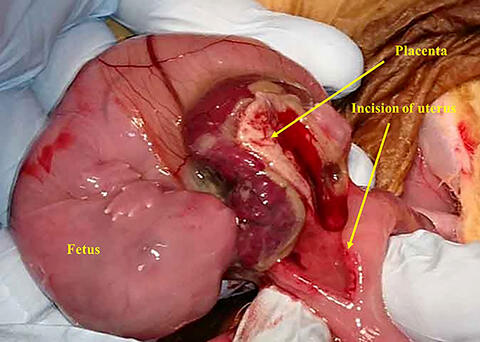Through applying artificial red blood cells (hemoglobin vesicles) during animal experiments, the research team consisting of Professor Manabu Kinoshita of the Department of Immunology and Microbiology in National Defense Medical College, Professor Hiromi Sakai of the Department of Chemistry in Nara Medical University, and Professor Katsuo Terui of the Department of Anesthesiology in Saitama Medical University General Medical Center succeeded in clarifying the possibility of saving lives by administering hemoglobin vesicles in cases of critical massive bleeding during delivery.
Obstetric (childbirth) hemorrhage is a serious condition that may develop suddenly in healthy pregnant women in labor and sometimes result in death; to address this and possibly save lives, prompt blood transfusion is needed. However, nearly 80% of small facilities, such as maternity hospitals, are poorly prepared for blood transfusion. Therefore, the research team has focused on searching for alternatives to blood transfusion in cases of massive bleeding during labor.
In this study, the researchers proved that hemoglobin vesicles could become an alternative for transfusion to avoid massive uterine hemorrhage during delivery, thereby preventing hemorrhagic shock. During the study, hemoglobin vesicles were administered to five rabbits with fatal massive hemorrhage, characterized as 60 minutes of bleeding from the uterine arteries and veins on one side of the pregnant uterus (subsequent ligation hemostasis). After 6 hours, all five rabbits survived, similarly to rabbits transfused with red blood cells and plasma.
Next, the situation of massive bleeding during actual delivery was assumed. For the first 30 minutes after massive bleeding occurred on a post-cesarean section rabbit, a plasma substitute was administered. In the next 30 minutes, either plasma substitutes or hemoglobin vesicles/red blood cells and plasma were administered. After 6 hours, all rabbits transfused with only plasma substitutes died, whereas all eight rabbits that were transfused with red blood cells and plasma survived. Moreover, eight out of 10 rabbits in the group treated with hemoglobin vesicles survived.
These results indicate that blood products should be transfused as early as possible during critical bleeding in obstetrics and other settings. However, when blood products are unavailable, hemoglobin vesicles can be administered during emergency transport of pregnant women to medical facilities. Professor Kinoshita said, "Hemoglobin vesicles can be administered regardless of blood type and can be stored at 4°C for 2 years, so they can be easily stockpiled even in small facilities such as maternity hospitals. For massive bleeding during labor, we expect that the lifesaving effect will be improved by transporting the patient to a large hospital while administering hemoglobin vesicles."
■ Hemoglobin Vesicles, also called red blood cell substitutes: Hemoglobin vesicles contain human hemoglobin in liposome particles with a diameter of about 250 nm and have the same oxygen-carrying capacity as natural red blood cells. The hemoglobin endoplasmic reticulum used in the study is currently being translated into clinical practice with the support of the Japan Agency for Medical Research and Development.

Provided by National Defence Medical College
This article has been translated by JST with permission from The Science News Ltd.(https://sci-news.co.jp/). Unauthorized reproduction of the article and photographs is prohibited.




